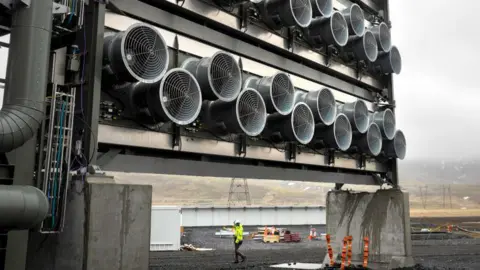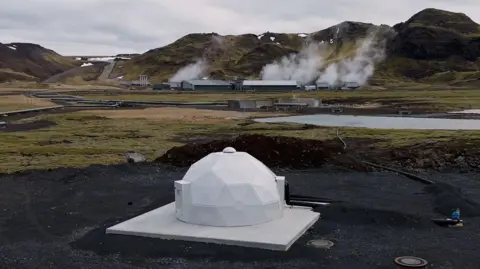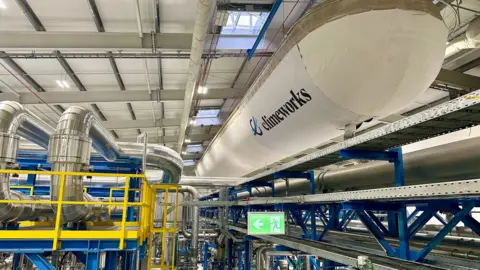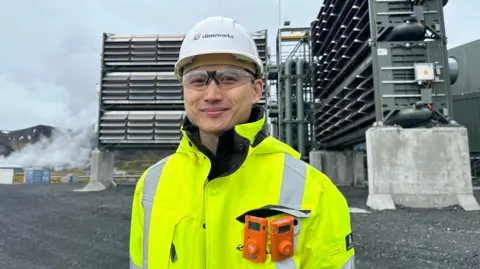Is carbon capture an efficient way to tackle CO2?
 Getty Images
Getty ImagesIt could be a scene from science fiction. Towering over dark, mossy lava fields are stacks of noisy machines the size of shipping containers, domes, and zig-zagging silver pipes.
Found 30km (19 miles) southwest of Iceland’s capital Reykjavik, this is the world’s largest direct air capture (DAC) facility.
Called Mammoth, it has been developed by Swiss firm Climeworks.
It has been running for two months, sucking global-warming carbon dioxide (CO2) out of the air, then storing it deep underground where it turns to stone.
Twelve collector containers are now installed, but in the coming months 72 of them will circle the large processing hall.
“That will enable us to capture 36,000 tons of CO2 every year,” Climeworks’ chief commercial officer, Douglas Chan, tells the BBC.
The idea is to reverse emissions that have already been pumped into the atmosphere.
Each collector unit has a dozen powerful fans, which, every 40 seconds, can suck up enough air to fill an Olympic swimming pool.
“The technology relies on sucking in lots and lots of air, slowing it down so that the filter can capture it, and then venting the air back out the end,” says Mr Chan.

CO2 only makes up a tiny proportion of the atmosphere (0.04%), so capturing it requires a lot of electricity.
For Mammoth that electricity comes from a neighbouring geothermal power plant, so, while operating, the plant is emissions free.
Once full, the collection chambers are flushed out with hot steam, which is piped into the processing hall.
Inside the hall, Mr Chan points out two enormous balloons overhead, which together hold a single tonne of CO2.
That captured CO2 is then mixed with fresh water, in an adjacent tower.
“It’s almost like a shower,” explains Dr Martin Voigt, from Icelandic firm Carbfix, which has developed a process to turn CO2 into stone.
“From the top, water trickles down. The CO2 is coming up, and we dissolve the CO2.”
Hidden inside two white, igloo-like domes nearby are injection wells, where the CO2-laden water is pumped more than 700m underground.

“This is a fresh basalt here,” says Dr Voight, showing me a lump of black rock taken from a recent volcanic eruption, and riddled with tiny holes. “You can see there's a lot of porosity.”
Iceland has an abundance of volcanic basalt, and this bedrock acts like a storage reservoir. When the carbon meets other elements found in the basalt, a reaction kicks off and it solidifies, locking it away as carbonate minerals.
“Here you can see a lot of these pores are now filled with whitish specks,” says Dr Voight, handling a sample of drilled out rock.
“Some of these are carbonate minerals. They contain the mineralised CO2.”
The process is quick, claims Dr Voight enthusiastically. “We're not talking about millions of years.”
“Around 95% of the CO2 was mineralised within two years in the pilot project. This is incredibly fast. On geological timescales at least.”

Capable of removing 36,000 tonnes of CO2 a year, an amount similar to taking 8,000 petrol cars off the road, Mammoth is almost 10 times larger than Climeworks’ first commercial plant called Orca.
It costs Climeworks almost $1,000 (£774) to capture and store a tonne of CO2. To make money it sells carbon offsets to clients.
“Mammoth has already sold close to a third of its lifetime capacity,” states Mr Chan, who believes technological improvements and scaling up, will drive down future costs.
“By the end of the decade, we want to be at a cost of capture of between $300 and $400.”
Among its customers are Microsoft, H&M, JP Morgan Chase, Shopify and Lego; as well as over 20,000 individuals who subscribe on Climeworks’ website.
“We're following the science,” Microsoft’s senior director of energy and carbon removal, Brian Marrs, previously told the BBC.
“Carbon removal has to be part of the equation. You can't reduce emissions that are already in the atmosphere, you have to remove them.”
Eventually Mammoth will be dwarfed by US-based Project Cypress, which breaks ground in 2026, and which Climeworks hopes will remove up to a million tonnes of CO2 annually, using new technology which it claims will be cheaper and more energy efficient.

DAC technology is, however, not without critics who think its over-hyped, pointing to high costs, high energy consumption and limited scale.
Those critics would argue that capturing CO2 where it is emitted would be far more efficient.
“It's much easier to remove the carbon dioxide directly from smokestacks,” says Dr Edvard Júlíus Sólnes, a professor at the University of Iceland and former Icelandic Environment Minister.
Despite repeated calls to curb emissions, a record amount of planet-heating CO2 was churned out last year.
The UN's Intergovernmental Panel on Climate Change has warned that emissions must be urgently slashed, but that still won’t be enough to prevent harmful global warming.
Many climate scientists agree that carbon removal will also be necessary but this also divides opinion. Multiple methods have emerged, and some caution against reliance on so-called techno-fixes, which might discourage polluters from changing their ways.
Currently no carbon removal is taking place at anywhere near the scale that would be needed.
“We release about 40 billion tonnes of carbon dioxide into the atmosphere every year, so this [DAC] won't make a dent in the big problem,” says Dr Sólnes.
“We need to divest from fossil fuels and find other sources of energy,” he asserts. “But I think we should use all methods to fight this problem.”
More DAC projects are getting off the ground. According to the International Energy Agency, 27 plants have been commissioned worldwide, but only four of them capture more than 1,000 tonnes of CO2 annually.
Plans for further 130 facilities are also on the drawing board, and around $3.5bn has also been earmarked by the US government to kickstart three large-scale hubs aimed at eventually removing a mega-tonne of CO2, per year.
However, Doug Chan is convinced that DAC can help battle global warming. “I really do believe direct air capture and other engineered solutions are going to get us to the point that we need to help fight climate change.”
